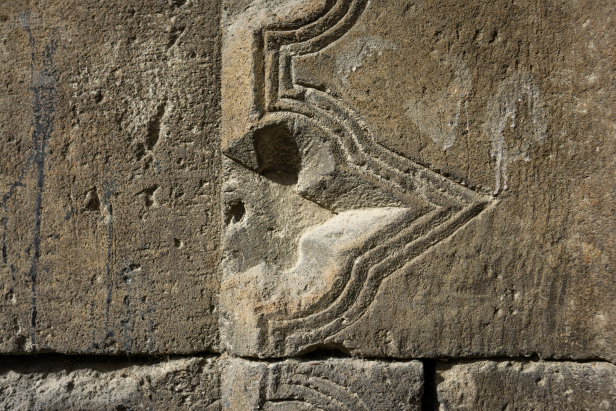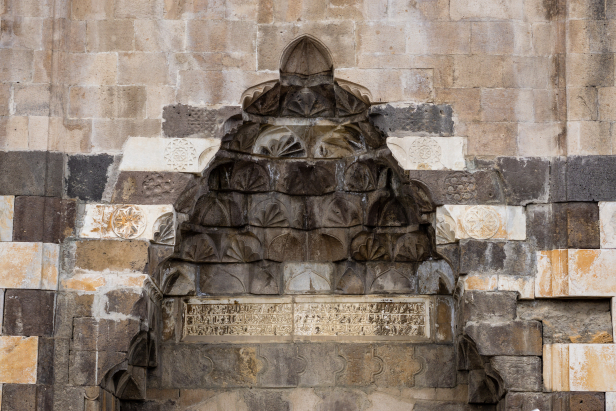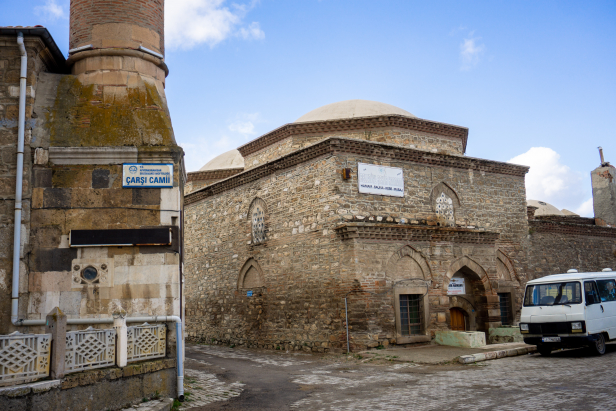Sahipata (Ishaklı) Caravanserai
Sahipatahan veya İshaklı Han
/ By Josh
Cost: Free
Great for: Seljuk History, Silk Road, Caravanserai, Road tripping
The Sahipata Caravanserai was built by Fahreddin Ali ibn Huseyin, better known as Sahip Ata, around the year 1250 during the reign of Seljuk Sultan Izzedin Keykavus II. The han (Caravanserai) was built to serve travellers along the road connecting Afyonkarahisar and Bolvadin with the Anatolian Seljuk capital city of Konya.
The current name of the town is Sultandağı which comes from the Sultan Mountains that backdrop the town. An older name for the town is Ishakli, which is sometimes used as the name for the caravanserai though its most common name is Sahip Ata, derived from the building’s patron.

Because of the shared name “Ishak” some locals attribute the building to Ishak Paşa, builder of the incredibly picturesque Ishak Paşa Palace in Ağrı Province, though, as that palace was built in the Ottoman era some 500 years later, this connection is clearly impossible.
The actual founder of the Sahipata Han is quite well known for his role in the Seljuk court as well as a patron of many other grand buildings. Sahip Ata is a well-known figure in this period in the region surrounding Konya. He served as grand vizir to Seljuk Sultans as well as to the Mongol rulers for around forty years. Today he is best known for the many buildings he commissioned including, Sahip Ata Madrasah (Konya), the Ince Minareli Madrasah (Konya), and the stunning Gök Madrasah (Sivas).
Subscribe to The Art of Wayfaring
Sahipata Han was built in the grand ‘Sultan Han’ style of Caravanserais found scattered across central Turkey. At the front of the building is its only entrance, the crown portal capped by a Muqarnas archway. This entryway opens into a wide courtyard surrounded by a covered porch.

In the center of the courtyard is a small prayerhall, built above the ground on four arches and reached by stairs. What makes this han particularly unique is the off-axis position of the prayer hall, which, by nature must face mecca. Most other caravanserai were built so as to naturally face Mecca (see Kayseri Sultanhan and Aksaray Sultanhan), so the fact that Sahip Ata Han does not suggests that the Han was built to integrate with the passing road or perhaps other buildings. In the masonry of the prayer hall you can see some spoila, respectfully displayed rather than simply reused.


The inscription in the crown portal is carved into a fine piece of marble. If you look at these blocks from the backside (interior of the entrance) you can see that these are actually spoila as well, bearing some large reliefs.
Beyond the forecourt and prayer hall is the grand hall, a fully covered section with light entering through the peaked cupola, typical of Seljuk architecture, and narrow slit windows in the heavy walls. The covered hall is entered through a subdued portal reminiscent of the scalloped portal at İncir Han in Burdur Province.
Sahipata Han was in a state of considerable ruin until major restoration work was carried out in 2009. The entire south wall of the forecourt had disappeared. Today this section has been rebuilt in a completely unhistorical style to house the public washrooms; the normal vaulting replaced with a single iwan. The space is now used as a café, full of antique items like wagons wheels, clay jars, and pitchforks. Overgrown with plants it’s an unusually green space.
Behind the caravanserai are a historic mosque, fountain, and bathhouse, believed to have been built some time during the Ottoman period. The bathhouse is no longer in use.
How To Get There
General
Sahipata Han is in the center of Sultandağ, a town along the Konya – Afyonkarahisar road (D300 highway) in the eastern edge of Afyonkarahisar Province. As a large town along a main road there is good public transit access from the cities of Afyon and Konya, as well as larger towns such as Akşahir.
By car the town of Sultandağ is 70 kms east of Afyon and 160 kms west of Konya.
For more about car rental and driving in Turkey make sure to read our full drivers guide.
Where To Stay
Most towns along the Afyon-Konya highway have a handful of low-end hotels to choose from, Sultandağ included. 27 kms away in the Town of Akşehir you’ll have a few more hotels to choose from including some better quality options. Further afield in Yalvaç (76kms), home to Pisidian Antioch, there are some good hotel options as well as some great sights to see. The cities of Afyon (70 kms) and Konya (160 kms) are large centers with loads of hotels of every type to choose from, including thermal spa hotels.
Other Tips
Planning on visiting Sahipata Han? Make sure to check out our guide to the nearby ruins of Pisidian Antioch and the other sights of the Province of Afyon and the rest of the Central Anatolia!
Subscribe to The Art of Wayfaring
Have any tips or info to add? Spot any mistakes? We’d love to hear about it.


